
Tile is possibly the biggest design element of any bathroom. And if you are working on a vintage bath, it’s important to use historic floor tile patterns that fit your home.
If your bathroom was “remudeled” in the past it can be hard to find a floor tile that will fit your home’s age and style. Most of these floor tile patterns were popular from the early 1900s until WWII and will fit nicely with any old house bathroom.
If your house is older than 1900, it’s very possible the bathroom was an addition since indoor plumbing wasn’t considered a necessity until after that time. Before then, only the wealthiest homes had a bathroom. The rest of the world made due with a chamber pot and a commode which was a type of a nightstand for when nature called in the middle of the night. Because of that most vintage bath designs, even on much older houses, will fit into the 1900-1930s style.
The small format of these tiles served an important purpose. The small size of most early 20th century bathrooms makes them poor candidates for large format tiles. These little tiles allowed for unique designs and the small tile made the cramped spaces feel much bigger than they actually were.
Hexagon
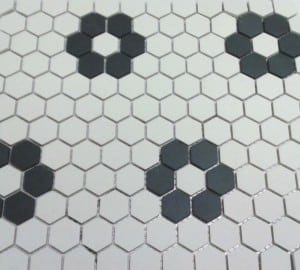
Image Credit: luxetile.com
Hexagon tiles (typically white) were a hugely popular choice for floor tile. The design of these can be as simple as all white or could contain a complex pattern of different colors and designs. Their small 1″ size allowed for some very creative mosaic patterns to be incorporated by a skilled tile setter.
Often times, the field of white hex tiles would be left bare with merely a mosaic border pattern in black or some other accent color to give a pop to the otherwise antiseptically white bathrooms of the day.
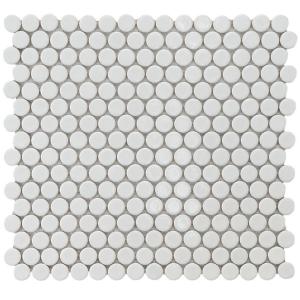
Image Credit: HomeDepot.com
Penny Round
Penny round tiles, while not as popular as their hexagon cousins, were another popular mosaic tile option. These tiles typically came in 3/4″ and 1″ size and because of their small size they create a very unique look, especially from a distance.
Their round shape creates a larger portion of grout than with most other tile options so grout color becomes very important with this style.
Square

Image Credit: Restorationtile.com
You don’t have to have odd shapes like hexagons or penny rounds to be in style with historic floor tile. Square mosaic tile fits the bill quite nicely. Little 1″ square tiles (3″ and larger tiles are a different style entirely) were another very popular choice for floor tile. Often, borders for the hex and penny round floors were done with 1″ square tiles in a multitude of colors.
Border designs like Greek keys, winding belts, family names, and any other imaginable designs were fairly common. While most popular in the borders, they were also readily used as field tile as well.
Basket Weave

Image Credit: merchantcircle.com
This style is not as difficult to install as it may look. These tiles come in 12″ x 12″ sheets, just like the hexagons and penny rounds. Usually black and white (which was the theme for the average home bathroom) this tile really gives the illusion of being weaved together. It’s a little more difficult to install since you have to be careful to follow the pattern precisely from sheet to sheet. Though this photo shows marble tile, it is available like all of these options in marble or ceramic.
Pinwheel
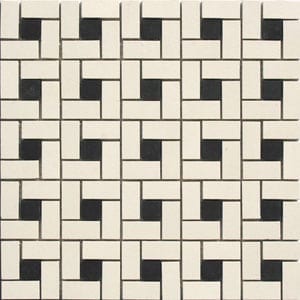
Image Credit: Mosaictilesupplies.com
Especially popular in the 1920s and 1930s, Pinwheel tile patterns are a simple and fun design. They were rarely any other color than the standard white with a black center, but on a rare occasion, you might find a dark blue tile in the center of the pattern.
This pattern works well in a large or small space and was also a popular option in kitchens of the day.
Block Random
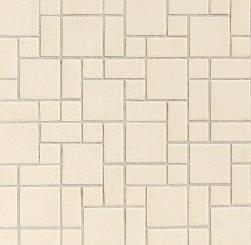
Image Credit: Daltile.com
It may seem as the name suggests, but this tile does actually have a specific pattern. This tile was fairly popular in the late 1930s and thru the 1940s in a variety of colors. The 1940s gave rise to thousands of color combinations for this tile pattern as it became increasingly popular throughout that decade.
If you have a historic house and you stick with one of these 6 historic floor tile patterns, no one will know it is anything other than original. Colors and patterns changed significantly over these decades.
The early 1900s were more colorful to fit the sensibilities of the fading Victorian style. Other than the earth colored tiles found in Craftsman style homes, the late 1910s and 1920s were obsessively white tiled rooms because of the recent discovery of germs and the resulting sanitary craze. It was thought that white made it easier to spot germs. The 1930s was a mix of the sanitary white and the crazy bold colors found in Art Deco homes. In the 1940s the other color schemes faded and pastels like pink (not a girl’s color at the time), blue, yellow, and green rose in popularity along with creme colors.
If you have one of these infamous pink bathrooms you should visit SaveThePinkBathrooms.com before ripping things out for some interesting perspectives on your bathroom.
Don’t be intimidated by the big prices on these small tiles. Buying enough tile to finish a bath as tiny as most historic bathrooms won’t break the bank. That leaves you the ability to spend more per square foot and get some really nice tile that will last as long as you old house has.
Subscribe Now For Your FREE eBook!

Founder & Editor-in-Chief
I love old houses, working with my hands, and teaching others the excitment of doing it yourself! Everything is teachable if you only give it the chance.

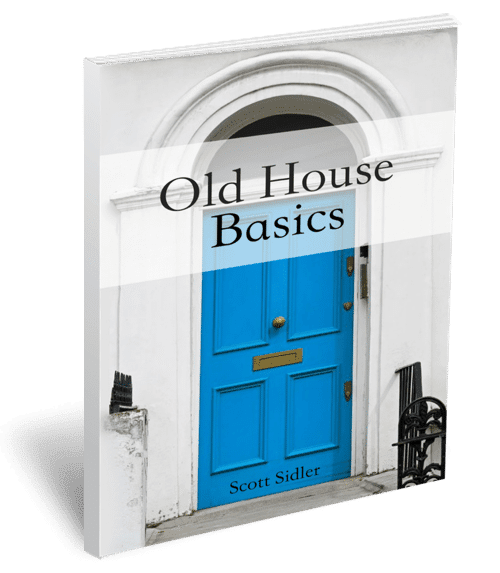
Hey Scott— During demo in our 1920 Jack n Jill bathroom, we unearthed perfect white porcelain hexagon tile. What is the best way to remove the grout/thinset residue? We do not want to damage this goldmine of a find!
Thanks!
i have also discovered the original white hex porcelain tile, but it was covered with carpeting!! Whats the best way to remove all that adhesive??
Would hex tile have been used in the front entry(possibly the coat room) of an 1895 schoolhouse? If not, any idea?
Hi Shirley,
I know you wrote this a long time ago, but we’re also fixing up a schoolhouse from the 1870’s. I’d love to know what you found out about the entry tile and I’d love to see any pictures of what you’ve done!
Best!
Eve
I am restoring a 1930 tudor .I founf the original marble black and white basketweave under a cheap tile floor its in great shape except for a settlement crack .any way to repair this?
Really tough to do if even possible. Any replacement tile usually looks new. I usually chalk it up to Historic character if it’s not too bad.
Thanks for posting this article, it is very informative. If you need any information in reference to Tiles Companies in India, do visit our website. http://www.oasistiles.in/
Hi I am interested in purchasing about 6 white pieces of the black and white pinwheel tile. Can I purchase it through you?
Susan we don’t sell it but the pinwheel isn’t too hard to source with an online search.
Hi Scott, my husband and I are restoring a 96 year old Craftsman. I love the black and white vintage/hexagon style tiles, but I’m having a hard time deciding on which one to go with. I wondered if you could tell me if there’s a certain pattern that is most authentic to an old Craftsman? This would be used in the bathroom. I’m debating between: small black and white hexagon tile, larger white hexagon tile, larger white with smaller black tiles and larger white with smaller grey tiles. I would love any feedback you might have! Thanks!
Hi Scott,
Would you say marble mosaic (spiral pinwheel, rounds, hexagons or basket weave) is historically correct to use as a bathroom floor in an apartment building that was built in the late 1950s? Floor is only 25 square feet. I am going for a black and white floor, with the original bluish gray tiles with black trim on its walls which are in v good shape, may need re-grouting.
The pinwheel black and white tiles with grey grout that are there now, while with no crack anywhere, look dirty and tired. I am going for a midcentury modern look in my remodel. I am not sure if marble mosaic and say basket weave or hexagon or rounds will make things look incongruous or inconsistent with the midcentury modern design.
Thanks
I would do either block random or pinwheel but I have yet to see marble versions in 1950s homes.
Sounds good. I may go for block random or even white round pebbles (pls comment if u disagree) esp if i change the blueish gray wall tiles down the road to something white for a cleaner airier feel. MCM was about simplicity after all. Thank you
I meant to say penny not pebble (round)
Rachel,
It seems a shame to remove the original tiles. Is there any way to have them deep cleaned?